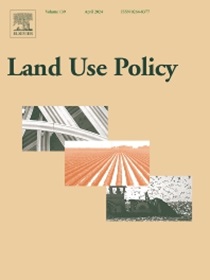Beyond the trees: Equity and justice in Nepal’s forest restoration
IF 5.9
1区 社会学
Q1 ENVIRONMENTAL STUDIES
引用次数: 0
Abstract
We examined equity and justice in forest restoration programs in Madhesh province in Nepal. We selected four sites that have three different tenure regimes, namely, community forest (Baghbhairav and Musahar), collaborative forest management (Tamagadhi), and forest protection area (Dhanushadham). The primary data were collected through focus group discussion, key informant interviews, field observations, and forest cover change analysis. We used ArcGIS to perform a spatial overlay analysis to identify the forest cover dynamic (1990, 2000, 2010, and 2022), followed by an examination of equity and justice under its four dimensions: contextual, procedural, distributive, and recognition. Atlas.ti, a computer-assisted software, was used to create codes, sub-themes, and themes from qualitative information, which were then used for further interpretations. Our findings indicated that while forest cover in the study sites is changing rapidly, with temporal and spatial variation across the sites, restoration and equity are inextricably linked and mutually reinforce each other. We also identified visible interactions among the four dimensions of equity, with each contributing to restoration in a different way. The paper concludes that multiple factors undermine forest restoration, among them, equity and justice,community heterogeneity, weak tenure rights, and conflicts over forest benefits sharing are the prominent. The findings imply that, for successful restoration, equity and justice must be considered as the core elements for both intrinsic and instrumental reasons.
树木之外:尼泊尔森林恢复的公平与正义
我们考察了尼泊尔马德什省森林恢复项目的公平性和正义性。我们选择了四个拥有三种不同权属制度的地点,即社区森林(Baghbhairav和Musahar)、合作森林管理(Tamagadhi)和森林保护区(Dhanushadham)。通过焦点小组讨论、关键信息提供者访谈、实地观察和森林覆盖变化分析收集了原始数据。我们使用ArcGIS进行空间覆盖分析,以确定森林覆盖动态(1990年、2000年、2010年和2022年),然后在四个维度下检查公平和正义:背景、程序、分配和识别。阿特拉斯。Ti是一种计算机辅助软件,用于从定性信息中创建代码、子主题和主题,然后用于进一步解释。研究结果表明,虽然研究地点的森林覆盖变化迅速,但在不同的时间和空间上存在差异,恢复与公平是密不可分的,相互促进的。我们还确定了公平的四个维度之间可见的相互作用,每个维度都以不同的方式促进恢复。研究认为,影响森林恢复的因素较多,其中公平正义、群落异质性、权属权利薄弱、森林利益分享冲突等因素最为突出。调查结果表明,为了成功地恢复,出于内在和工具原因,必须将公平和正义视为核心因素。
本文章由计算机程序翻译,如有差异,请以英文原文为准。
求助全文
约1分钟内获得全文
求助全文
来源期刊

Land Use Policy
ENVIRONMENTAL STUDIES-
CiteScore
13.70
自引率
8.50%
发文量
553
期刊介绍:
Land Use Policy is an international and interdisciplinary journal concerned with the social, economic, political, legal, physical and planning aspects of urban and rural land use.
Land Use Policy examines issues in geography, agriculture, forestry, irrigation, environmental conservation, housing, urban development and transport in both developed and developing countries through major refereed articles and shorter viewpoint pieces.
 求助内容:
求助内容: 应助结果提醒方式:
应助结果提醒方式:


